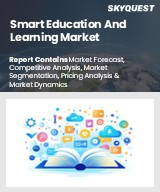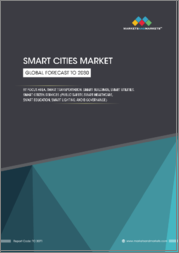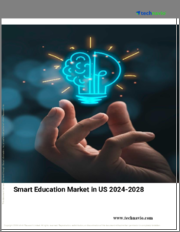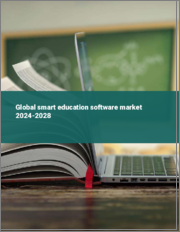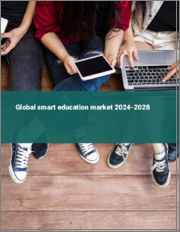
|
시장보고서
상품코드
1603790
스마트 교육 및 학습 시장 예측(-2030년) : 컴포넌트별, 도입 모드별, 학습 모드별, 교육 컨텐츠별, 기술별, 용도별, 최종사용자별, 지역별 세계 분석Smart Education & Learning Market Forecasts to 2030 - Global Analysis By Component (Hardware, Software and Services), Deployment Mode (Cloud-Based and On-Premises), Learning Mode, Educational Content, Technology, Application, End User and By Geography |
||||||
Stratistics MRC에 따르면 세계의 스마트 교육·학습 시장은 2024년에 681억 2,000만 달러를 차지하며 예측 기간 중 CAGR은 20.4%로 성장하며, 2030년에는 1,594억 8,000만 달러에 달할 것으로 예측됩니다.
스마트 교육 및 학습은 AI, 클라우드 컴퓨팅, VR, 모바일 애플리케이션과 같은 디지털 툴을 사용하여 교육 컨텐츠를 학습자 개개인의 필요에 맞게 조정하여 교육 컨텐츠를 보다 친숙하고 매력적으로 만드는 기술을 통합한 첨단 교육 접근 방식을 말합니다. 교육 컨텐츠를 개별 학습자의 요구에 맞게 조정하여 교육을 보다 친숙하고 매력적으로 만듭니다. 스마트 교육은 데이터베이스 인사이트와 적응형 학습 경로를 통해 교육 기관이 교육 전략을 최적화하고, 평생 학습을 촉진하며, 학생들이 디지털화된 미래를 준비할 수 있도록 돕습니다.
유네스코 국제농촌교육연구훈련센터(UNESCO INRULED)와 북경사범대학 스마트학습연구소(SLIBNU)는 중국 교육부가 지난 3월 SLIBNU)의 발표에 따르면 2020년 3월 중국 교육부는 "Disrupted classes, Undisrupted Learning" 프로그램을 통해 2억 7,000만 명 이상의 학생들에게 집에서 유연한 온라인 학습을 제공하는 구상을 취했다고 합니다.
디지털 학습의 도입 확대
교육기관, 대학, 기업은 디지털 플랫폼, e-learning 솔루션, 온라인 평가 등을 도입하면서 스마트 교육 툴에 대한 수요가 급증하고 있으며, AI, 클라우드 컴퓨팅, 인터랙티브 컨텐츠는 다양한 학습 스타일과 일정에 맞추어 개인화된 학습 경험을 제공합니다. 다양한 학습 스타일과 일정에 맞는 개인화된 학습 경험을 가능하게 합니다. 이러한 전환은 평생 교육과 기술 향상을 장려하는 동시에 원격으로 유연한 학습을 촉진합니다. 그 결과, 교육 기관, 기업 및 정부 지원 프로그램에서 스마트 기술을 광범위하게 채택하여 시장의 급격한 성장을 주도하고 있습니다.
제한적인 디지털 리터러시
디지털 리터러시가 제한적이기 때문에 인구의 상당 부분이 기술 기반 교육 솔루션의 혜택을 충분히 누리지 못하고 있습니다. 디지털 문해력이 낮은 지역에서는 학생과 교육자 모두 첨단 학습 플랫폼을 사용하는 데 어려움을 겪을 수 있으며, 이는 효과적인 도입을 방해할 수 있습니다. 이러한 기술 부족은 디지털 툴의 활용 부족으로 이어져 스마트 교육 기술의 효과를 떨어뜨립니다. 또한 변화에 대한 저항과 교육에 대한 필요성은 이러한 기술의 도입을 더욱 지연시키고 특정 분야 시장 성장 잠재력을 제한하고 있습니다.
유연한 학습에 대한 수요 증가
학생과 전문가들이 개인화된 학습 옵션을 원하는 가운데, 전통적인 교육 모델은 원격 학습과 하이브리드 학습 솔루션을 제공하는 디지털 플랫폼으로 대체되고 있습니다. 유연한 학습은 다양한 일정과 학습 스타일에 대응하여 더 많은 사람들이 교육을 받을 수 있도록 돕습니다. 첨단 기술은 맞춤형 컨텐츠를 가능하게 하고, 모바일 및 온라인 플랫폼은 언제 어디서나 학습할 수 있는 유연성을 제공합니다. 이러한 유연성에 대한 요구가 높아지면서 교육 기관과 학습자들이 스마트 교육 솔루션을 도입하고 있으며, 이는 시장 성장을 가속화하고 있습니다.
높은 초기 투자
스마트 교육 및 학습의 높은 초기 투자 비용은 디지털 학습 시스템 도입에 필요한 첨단 기술, 인프라 및 컨텐츠 개발 비용에 기인합니다. 학교, 대학 및 조직은 하드웨어, 소프트웨어, 교육 및 지속적인 지원에 투자해야 합니다. 소규모 교육 기관은 자원 배분에 어려움을 겪기 때문에 초기 비용이 도입의 걸림돌이 되어 시장 성장을 둔화시킬 수 있습니다. 또한 지속적인 업데이트와 유지보수는 재정적 부담을 더욱 가중시켜 보급에 걸림돌이 될 수 있습니다.
COVID-19의 영향
COVID-19 팬데믹으로 인해 전 세계에서 학교와 교육기관이 원격 교육을 위해 디지털 플랫폼을 채택하면서 스마트 교육 및 학습 시장이 크게 성장하고 있습니다. 접근성이 높고 유연한 학습에 대한 요구는 AI 기반 개인화, 게임화된 컨텐츠, 클라우드 기반 협업 툴와 같은 혁신을 촉진하여 원격 교육의 효과를 높였습니다. 이러한 변화는 스마트 교육 기술의 가치를 강조하고 디지털 인프라에 대한 대규모 투자, 시장 확대, 온라인 학습이 현대 교육의 핵심 요소로 자리 잡도록 이끌었습니다.
예측 기간 중 비디오 기반 컨텐츠 부문이 가장 큰 비중을 차지할 전망
동영상 기반 컨텐츠 분야는 예측 기간 중 가장 큰 시장 점유율을 차지할 것으로 예상됩니다. 동영상 기반 컨텐츠를 통한 스마트 교육 및 학습은 인터랙티브하고 매력적이며 쉽게 접근할 수 있는 학습 경험을 제공함으로써 기존의 교육 방식을 변화시키고 있습니다. 튜토리얼, 강의, 시뮬레이션과 같은 동영상 컨텐츠는 시각 및 청각 학습자를 대상으로 하여 이해를 돕습니다. 비디오 기반 학습은 공식 교육 및 기업 교육 모두에서 필수적인 요소로 자리 잡았으며, 유지율과 참여도를 향상시키는 확장 가능하고 비용 효율적인 솔루션을 제공합니다.
예측 기간 중 디지털 평가 부문이 가장 높은 CAGR을 나타낼 것으로 전망
디지털 평가 부문은 예측 기간 중 가장 높은 CAGR을 나타낼 것으로 예상됩니다. 디지털 평가의 스마트 교육 및 학습은 기술을 활용하여 효율적이고 확장 가능하며 개인화된 평가 방법을 구축하며, AI 기반 툴 및 온라인 플랫폼을 통해 디지털 평가는 실시간 피드백, 자동 채점, 개별 학생의 요구에 맞는 적응형 테스트를 제공합니다. 적응형 테스트를 제공합니다. 이를 통해 교육자는 진행 상황을 추적하고, 격차를 파악하고, 교방법을 최적화할 수 있으며, 학생 성적 평가에 대한 보다 종합적이고 데이터베이스 접근 방식을 제공할 수 있습니다.
가장 큰 점유율을 차지하는 지역 :
아시아태평양은 정부의 교육 디지털화 및 이러닝 지원 정책으로 인해 예측 기간 중 가장 큰 시장 점유율을 기록할 것으로 예상됩니다. 중국, 인도, 일본 등의 국가들은 디지털 교실, AI 기반 교육 툴, 온라인 플랫폼에 투자하여 접근성과 참여도를 높이고 있으며, 에듀테크 기업은 언어 학습 앱, 게임화, 가상 튜터링으로 혁신을 주도하고 있습니다. 교육기관이 다양한 학습 요구를 충족시키기 위해 스마트 기술을 채택하는 경향이 증가하고 있으며, 이 시장은 성장할 것으로 예상됩니다.
CAGR이 가장 높은 지역 :
북미는 첨단 기술 도입과 디지털 교육에 대한 활발한 투자에 힘입어 예측 기간 중 가장 높은 CAGR을 나타낼 것으로 예상됩니다. 미국은 학교와 대학에서 AI, VR, 클라우드 기반 학습 플랫폼을 광범위하게 통합하여 개인화된 원격 학습 경험을 강화하는 데 앞장서고 있습니다. 구글(Google LLC), 피어슨 에듀케이션(Pearson Education) 등 주요 기업은 게임화 컨텐츠와 데이터 분석에 대한 혁신적 노력을 기울이고 있으며, 정부의 지원과 높은 인터넷 접근성 덕분에 북미는 전 세계 에듀테크 환경에서 매우 중요한 지역으로 부상하고 있습니다.
무료 맞춤형 서비스 :
이 보고서를 구독하는 고객은 다음과 같은 무료 맞춤화 옵션 중 하나를 사용할 수 있습니다. :
- 기업 개요
- 추가 시장 기업 종합 프로파일링(최대 3사)
- 주요 기업의 SWOT 분석(최대 3사)
- 지역 세분화
- 고객의 관심에 따른 주요 국가별 시장 추정치, 예측, CAGR(주: 타당성 확인에 따라 다름)
- 경쟁사 벤치마킹
- 제품 포트폴리오, 지역적 입지, 전략적 제휴를 기반으로 한 주요 기업 벤치마킹
목차
제1장 개요
제2장 서문
- 개요
- 이해관계자
- 조사 범위
- 조사 방법
- 데이터 마이닝
- 데이터 분석
- 데이터 검증
- 조사 어프로치
- 조사 정보원
- 1차 조사 정보원
- 2차 조사 정보원
- 전제조건
제3장 시장 동향 분석
- 촉진요인
- 억제요인
- 기회
- 위협
- 기술 분석
- 용도 분석
- 최종사용자 분석
- 신흥 시장
- COVID-19의 영향
제4장 Porter's Five Forces 분석
- 공급 기업의 교섭력
- 바이어의 교섭력
- 대체품의 위협
- 신규 진출업체의 위협
- 경쟁 기업 간 경쟁 관계
제5장 세계의 스마트 교육·학습 시장 : 컴포넌트별
- 하드웨어
- 인터랙티브 화이트보드
- 노트북/태블릿
- 프로젝터
- 인터랙티브 디스플레이
- 웨어러블 디바이스
- 소프트웨어
- 학습 관리 시스템(LMS)
- 학습 컨텐츠 관리 시스템(LCMS)
- 학생 정보 시스템(SIS)
- 적응형 학습 플랫폼
- 평가 소프트웨어
- 서비스
- 전문적 트레이닝과 개발
- 실장 및 통합 서비스
- 컨설팅 서비스
- 지원과 정비
제6장 세계의 스마트 교육·학습 시장 : 도입 모드별
- 클라우드 기반
- 온프레미스
제7장 세계의 스마트 교육·학습 시장 : 학습 모드별
- 셀프 페이스 학습
- 인스트럭터 주도 학습
- 블렌드형 학습
- 협동 학습
- 기타 학습 모드
제8장 세계의 스마트 교육·학습 시장 : 교육 컨텐츠별
- 오디오 기반 컨텐츠
- 텍스트 기반 컨텐츠
- 비디오 기반 컨텐츠
- 게임화 컨텐츠
- 기타 교육 컨텐츠
제9장 세계의 스마트 교육·학습 시장 : 기술별
- 인공지능(AI)
- 빅데이터 분석
- 사물인터넷(IoT)
- 증강현실(AR)과 가상현실(VR)
- 블록체인
- 기타 기술
제10장 세계의 스마트 교육·학습 시장 : 용도별
- 기업 학습
- 시뮬레이션 기반 학습
- 소셜 학습
- 가상 교실
- 디지털 평가
- 스킬 개발
- 기타 용도
제11장 세계의 스마트 교육·학습 시장 : 최종사용자별
- 학생
- 교사/인스트럭터
- 관리자
- 부모
제12장 세계의 스마트 교육·학습 시장 : 지역별
- 북미
- 미국
- 캐나다
- 멕시코
- 유럽
- 독일
- 영국
- 이탈리아
- 프랑스
- 스페인
- 기타 유럽
- 아시아태평양
- 일본
- 중국
- 인도
- 호주
- 뉴질랜드
- 한국
- 기타 아시아태평양
- 남미
- 아르헨티나
- 브라질
- 칠레
- 기타 남미
- 중동 및 아프리카
- 사우디아라비아
- 아랍에미리트
- 카타르
- 남아프리카공화국
- 기타 중동 및 아프리카
제13장 주요 발전
- 계약, 파트너십, 협업, 합병사업
- 인수와 합병
- 신제품 발매
- 사업 확대
- 기타 주요 전략
제14장 기업 프로파일링
- Adobe Systems Inc.
- Blackboard Inc.
- Cisco Systems Inc.
- Google LLC
- IBM Corporation
- Microsoft Corporation
- Lenovo Group
- Pearson Education
- Samsung Electronics Corporation
- SAP SE
- D2L Corporation
- Educomp Solutions Limited
- Ellucian Company L.P.
- Instructure Inc.
- McGraw-Hill Education
- Smart Technologies Inc.
- Udacity Inc.
- Promethean World Limited
- Saba Software Inc.
- NIIT Limited
According to Stratistics MRC, the Global Smart Education & Learning Market is accounted for $68.12 billion in 2024 and is expected to reach $159.48 billion by 2030 growing at a CAGR of 20.4% during the forecast period. Smart Education & Learning refers to an advanced educational approach that integrates technology to create interactive, personalized, and efficient learning environments. Using digital tools like AI, cloud computing, VR, and mobile applications, it tailors educational content to individual learners' needs, making education more accessible and engaging. With its data-driven insights and adaptive learning paths, smart education enables institutions to optimize teaching strategies, promote lifelong learning, and prepare students for a digital future.
According to publication by UNESCO International Research and Training Centre for Rural Education (UNESCO INRULED) and Smart Learning Institute of Beijing Normal University (SLIBNU), in March 2020, China Ministry of Education has taken an initiative to provide flexible online learning to over 270 million students from their homes through "Disrupted classes, Undisrupted Learning'' program.
Market Dynamics:
Driver:
Increased adoption of digital learning
Educational institutions, universities, and businesses are adopting digital platforms, e-learning solutions, and online assessments, leading to a surge in demand for smart education tools. AI, cloud computing, and interactive content enable personalized learning experiences that accommodate various learning styles and schedules. This transition fosters remote and flexible learning while encouraging lifelong education and skill enhancement. As a result, there is a broad adoption of smart technologies across educational establishments, businesses, and government-backed programs, driving the rapid growth of the market.
Restraint:
Limited digital literacy
Limited digital literacy prevents a significant portion of the population from fully benefiting from technology-driven education solutions. In regions with low digital literacy, both students and educators may struggle to use advanced learning platforms, hindering effective adoption. This lack of skills leads to underutilization of digital tools, reducing the impact of smart education technologies. Additionally, resistance to change and the need for training further slow down the implementation of these technologies, limiting the market's growth potential in certain areas.
Opportunity:
Rising demand for flexible learning
As students and professionals seek personalized, self-paced learning options, traditional education models are increasingly being replaced by digital platforms offering remote and hybrid learning solutions. Flexible learning accommodates diverse schedules and learning styles, making education more accessible to a wider audience. Advanced technologies enable tailored content, while mobile and online platforms provide the flexibility to learn anytime, anywhere. This growing need for flexibility fuels market growth by encouraging institutions and learners to adopt smart education solutions.
Threat:
High initial investment
The high initial investment in smart education & learning arises from the cost of advanced technologies, infrastructure, and content development required to implement digital learning systems. Schools, universities, and organizations must invest in hardware, software, training, and ongoing support. The upfront costs may deter adoption, slowing the market's growth, as smaller institutions struggle to allocate resources. Additionally, continuous updates and maintenance further contribute to the financial strain, hindering widespread adoption.
Covid-19 Impact
The covid-19 pandemic significantly accelerated the smart education & learning market, as schools and institutions globally adopted digital platforms for remote education. The need for accessible, flexible learning drove innovations in AI-driven personalization, gamified content, and cloud-based collaboration tools, enhancing the effectiveness of remote education. This shift underscored the value of smart education technologies, leading to substantial investment in digital infrastructure, expanding the market, and establishing online learning as a core component of modern education.
The video-based content segment is expected to be the largest during the forecast period
The video-based content segment is predicted to secure the largest market share throughout the forecast period. Smart education & learning through video-based content is transforming traditional teaching methods by offering interactive, engaging, and easily accessible learning experiences. Video content, such as tutorials, lectures, and simulations, enhances understanding by catering to visual and auditory learners. Video-based learning has become essential in both formal education and corporate training, offering scalable, cost-effective solutions that improve retention and engagement.
The digital assessments segment is expected to have the highest CAGR during the forecast period
The digital assessments segment is anticipated to witness the highest CAGR during the forecast period. Smart education & learning in digital assessments leverages technology to create efficient, scalable, and personalized evaluation methods. Through AI-driven tools and online platforms, digital assessments offer real-time feedback, automated grading and adaptive testing that tailors to individual student needs. They enable educators to track progress, identify gaps, and optimize teaching methods, providing a more comprehensive and data-driven approach to student performance evaluation.
Region with largest share:
Asia Pacific is expected to register the largest market share during the forecast period driven by digital transformation in education and government initiatives supporting e-learning. Countries like China, India, and Japan are investing in digital classrooms, AI-powered education tools, and online platforms to enhance access and engagement. EdTech companies are innovating with language learning apps, gamification, and virtual tutoring. This market is projected to grow as educational institutions increasingly adopt smart technologies to meet diverse learning needs.
Region with highest CAGR:
North America is projected to witness the highest CAGR over the forecast period propelled by advanced technology adoption and strong investment in digital education. The United States leads with widespread integration of AI, VR, and cloud-based learning platforms in schools and universities, enhancing personalized and remote learning experiences. Key players such as Google LLC and Pearson Education innovate with gamified content and data analytics, while government support and high internet accessibility make North America a pivotal region in the global EdTech landscape.
Key players in the market
Some of the key players profiled in the Smart Education & Learning Market include Adobe Systems Inc., Blackboard Inc., Cisco Systems Inc., Google LLC, IBM Corporation, Microsoft Corporation, Lenovo Group, Pearson Education, Samsung Electronics Corporation, SAP SE, D2L Corporation, Educomp Solutions Limited, Ellucian Company L.P., Instructure Inc., McGraw-Hill Education, Smart Technologies Inc., Udacity Inc., Promethean World Limited, Saba Software Inc. and NIIT Limited.
Key Developments:
In June 2024, Samsung launched an initiative to transform classrooms across India with interactive learning technology. The solutions feature interactive digital boards and advanced Samsung tablets, designed to create more dynamic and engaging classrooms, particularly in underserved regions.
In May 2024, Google added AI-driven tools to Google Classroom aimed at enhancing student engagement and supporting teachers with grading assistance and personalized feedback. This update includes features like adaptive assessments and insights into student learning patterns, designed to make learning more accessible and tailored to each student's needs launches reflect a growing trend in integrating AI and cloud-based solutions to create more efficient and personalized education experiences worldwide.
Components Covered:
- Hardware
- Software
- Services
Deployment Modes Covered:
- Plant-Based Milks
- Plant-Based Yogurts
- Plant-Based Cheeses
- Plant-Based Ice Creams
- Plant-Based Butters
- Other Types
Learning Modes Covered:
- Self-Paced Learning
- Instructor-Led Learning
- Blended Learning
- Collaborative Learning
- Other Learning Modes
Educational Contents Covered:
- Audio-Based Content
- Text-Based Content
- Video-Based Content
- Gamified Content
- Other Educational Contents
Technologies Covered:
- Artificial Intelligence (AI)
- Big Data Analytics
- Internet of Things (IoT)
- Augmented Reality (AR) & Virtual Reality (VR)
- Blockchain
- Other Technologies
Applications Covered:
- Corporate Learning
- Simulation-based Learning
- Social Learning
- Virtual Classrooms
- Digital Assessments
- Skill Development
- Other Applications
End Users Covered:
- Students
- Teachers/Instructors
- Administrators
- Parents
Regions Covered:
- North America
- US
- Canada
- Mexico
- Europe
- Germany
- UK
- Italy
- France
- Spain
- Rest of Europe
- Asia Pacific
- Japan
- China
- India
- Australia
- New Zealand
- South Korea
- Rest of Asia Pacific
- South America
- Argentina
- Brazil
- Chile
- Rest of South America
- Middle East & Africa
- Saudi Arabia
- UAE
- Qatar
- South Africa
- Rest of Middle East & Africa
What our report offers:
- Market share assessments for the regional and country-level segments
- Strategic recommendations for the new entrants
- Covers Market data for the years 2022, 2023, 2024, 2026, and 2030
- Market Trends (Drivers, Constraints, Opportunities, Threats, Challenges, Investment Opportunities, and recommendations)
- Strategic recommendations in key business segments based on the market estimations
- Competitive landscaping mapping the key common trends
- Company profiling with detailed strategies, financials, and recent developments
- Supply chain trends mapping the latest technological advancements
Free Customization Offerings:
All the customers of this report will be entitled to receive one of the following free customization options:
- Company Profiling
- Comprehensive profiling of additional market players (up to 3)
- SWOT Analysis of key players (up to 3)
- Regional Segmentation
- Market estimations, Forecasts and CAGR of any prominent country as per the client's interest (Note: Depends on feasibility check)
- Competitive Benchmarking
- Benchmarking of key players based on product portfolio, geographical presence, and strategic alliances
Table of Contents
1 Executive Summary
2 Preface
- 2.1 Abstract
- 2.2 Stake Holders
- 2.3 Research Scope
- 2.4 Research Methodology
- 2.4.1 Data Mining
- 2.4.2 Data Analysis
- 2.4.3 Data Validation
- 2.4.4 Research Approach
- 2.5 Research Sources
- 2.5.1 Primary Research Sources
- 2.5.2 Secondary Research Sources
- 2.5.3 Assumptions
3 Market Trend Analysis
- 3.1 Introduction
- 3.2 Drivers
- 3.3 Restraints
- 3.4 Opportunities
- 3.5 Threats
- 3.6 Technology Analysis
- 3.7 Application Analysis
- 3.8 End User Analysis
- 3.9 Emerging Markets
- 3.10 Impact of Covid-19
4 Porters Five Force Analysis
- 4.1 Bargaining power of suppliers
- 4.2 Bargaining power of buyers
- 4.3 Threat of substitutes
- 4.4 Threat of new entrants
- 4.5 Competitive rivalry
5 Global Smart Education & Learning Market, By Component
- 5.1 Introduction
- 5.2 Hardware
- 5.2.1 Interactive Whiteboards
- 5.2.2 Laptops/Tablets
- 5.2.3 Projectors
- 5.2.4 Interactive Displays
- 5.2.5 Wearable Devices
- 5.3 Software
- 5.3.1 Learning Management Systems (LMS)
- 5.3.2 Learning Content Management Systems (LCMS)
- 5.3.3 Student Information Systems (SIS)
- 5.3.4 Adaptive Learning Platforms
- 5.3.5 Assessment Software
- 5.4 Services
- 5.4.1 Professional Training & Development
- 5.4.2 Implementation & Integration Services
- 5.4.3 Consulting Services
- 5.4.4 Support & Maintenance
6 Global Smart Education & Learning Market, By Deployment Mode
- 6.1 Introduction
- 6.2 Cloud-Based
- 6.3 On-Premises
7 Global Smart Education & Learning Market, By Learning Mode
- 7.1 Introduction
- 7.2 Self-Paced Learning
- 7.3 Instructor-Led Learning
- 7.4 Blended Learning
- 7.5 Collaborative Learning
- 7.6 Other Learning Modes
8 Global Smart Education & Learning Market, By Educational Content
- 8.1 Introduction
- 8.2 Audio-Based Content
- 8.3 Text-Based Content
- 8.4 Video-Based Content
- 8.5 Gamified Content
- 8.6 Other Educational Contents
9 Global Smart Education & Learning Market, By Technology
- 9.1 Introduction
- 9.2 Artificial Intelligence (AI)
- 9.3 Big Data Analytics
- 9.4 Internet of Things (IoT)
- 9.5 Augmented Reality (AR) & Virtual Reality (VR)
- 9.6 Blockchain
- 9.7 Other Technologies
10 Global Smart Education & Learning Market, By Application
- 10.1 Introduction
- 10.2 Corporate Learning
- 10.3 Simulation-based Learning
- 10.4 Social Learning
- 10.5 Virtual Classrooms
- 10.6 Digital Assessments
- 10.7 Skill Development
- 10.8 Other Applications
11 Global Smart Education & Learning Market, By End User
- 11.1 Introduction
- 11.2 Students
- 11.3 Teachers/Instructors
- 11.4 Administrators
- 11.5 Parents
12 Global Smart Education & Learning Market, By Geography
- 12.1 Introduction
- 12.2 North America
- 12.2.1 US
- 12.2.2 Canada
- 12.2.3 Mexico
- 12.3 Europe
- 12.3.1 Germany
- 12.3.2 UK
- 12.3.3 Italy
- 12.3.4 France
- 12.3.5 Spain
- 12.3.6 Rest of Europe
- 12.4 Asia Pacific
- 12.4.1 Japan
- 12.4.2 China
- 12.4.3 India
- 12.4.4 Australia
- 12.4.5 New Zealand
- 12.4.6 South Korea
- 12.4.7 Rest of Asia Pacific
- 12.5 South America
- 12.5.1 Argentina
- 12.5.2 Brazil
- 12.5.3 Chile
- 12.5.4 Rest of South America
- 12.6 Middle East & Africa
- 12.6.1 Saudi Arabia
- 12.6.2 UAE
- 12.6.3 Qatar
- 12.6.4 South Africa
- 12.6.5 Rest of Middle East & Africa
13 Key Developments
- 13.1 Agreements, Partnerships, Collaborations and Joint Ventures
- 13.2 Acquisitions & Mergers
- 13.3 New Product Launch
- 13.4 Expansions
- 13.5 Other Key Strategies
14 Company Profiling
- 14.1 Adobe Systems Inc.
- 14.2 Blackboard Inc.
- 14.3 Cisco Systems Inc.
- 14.4 Google LLC
- 14.5 IBM Corporation
- 14.6 Microsoft Corporation
- 14.7 Lenovo Group
- 14.8 Pearson Education
- 14.9 Samsung Electronics Corporation
- 14.10 SAP SE
- 14.11 D2L Corporation
- 14.12 Educomp Solutions Limited
- 14.13 Ellucian Company L.P.
- 14.14 Instructure Inc.
- 14.15 McGraw-Hill Education
- 14.16 Smart Technologies Inc.
- 14.17 Udacity Inc.
- 14.18 Promethean World Limited
- 14.19 Saba Software Inc.
- 14.20 NIIT Limited









